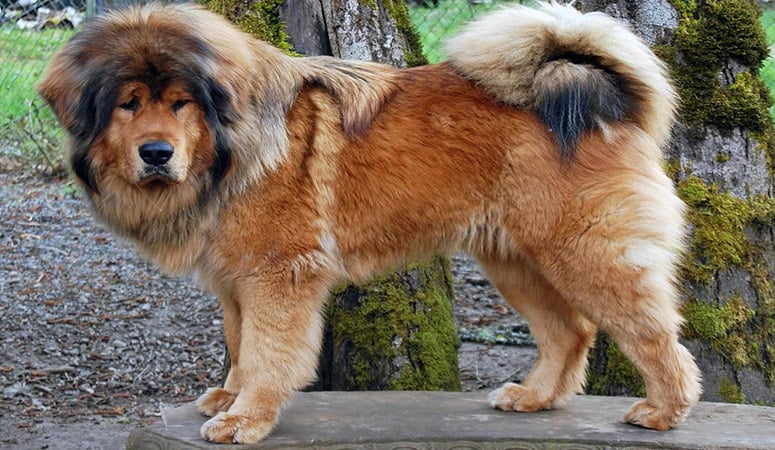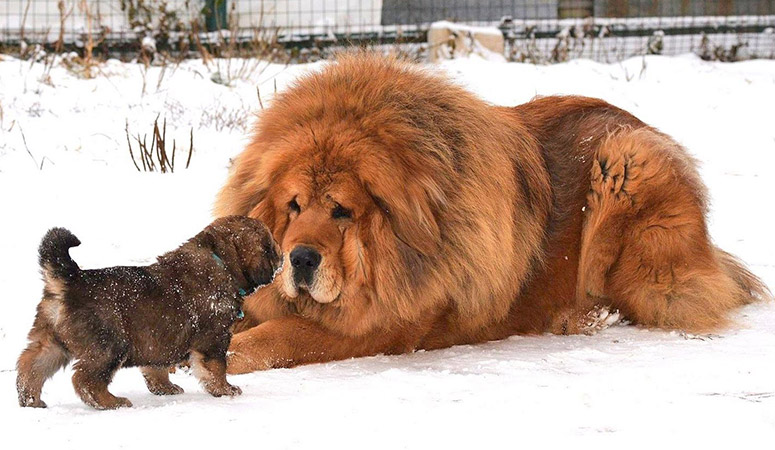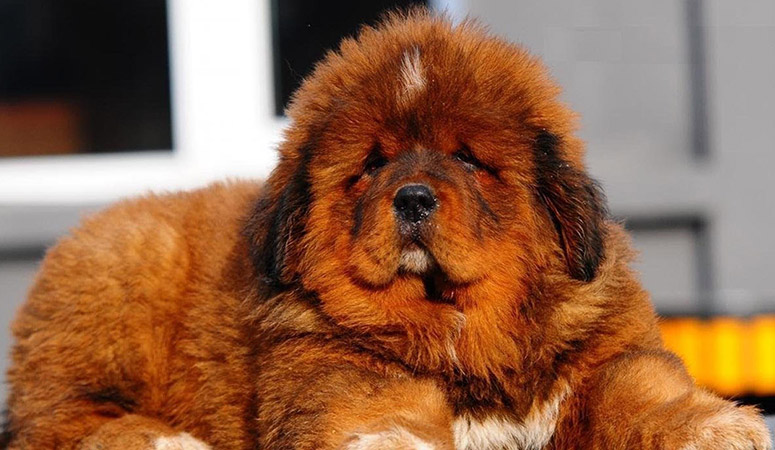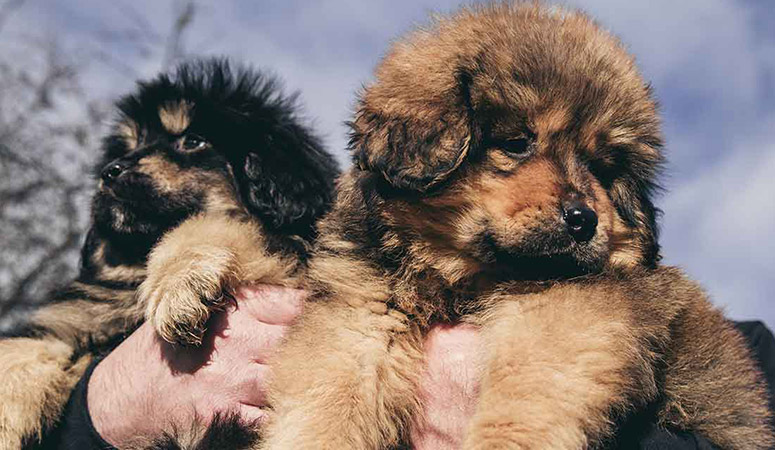Tibetan Mastiff

The Tibetan Mastiff combines agility and strength with powerful and athletic build. This breed has an impressive appearance with solemn but kindly expression. They are independent, calm, reserved, and watchful, which makes them step between their people and danger when they sense a threat. The dogs are devoted, and fiercely protective of their families.
| Other Names | Do-Khyi |
| Color | Black, Black & Tan, Blue Gray, Blue Gray & Tan, Brown, Brown & Tan, Red Gold, Red Gold |
| Height | Males: 26-30 inches. Females: 24-28 inches. |
| Weight | Males: 100-160 pounds. Females: 75-120 pounds. |
| Life Span | 6 to 12 puppies |
| Personality | Independent, Reserved, Intelligent |
| Exercise | Regular Exercise |
| Origin |
| Popularity | #128 |
| Groom Needs | 2-3 Times a Week Brushing |
| Kids Friendly | Yes with supervision |
| Dog Friendly | Yes with supervision |
| Watch Dog | Yes |
| Family Dog | |
| Litter Size | 6 to 12 puppies |
Tibetan Mastiff Pictures
Tibetan Mastiff Video
Introduction
The Tibetan Mastiff is a mastiff-type dog breed of ancient Tibet and the Himalayas. They possess marked hardiness that is required to survive the harsh conditions prevalent in the flatlands land regions they originated from. Although they are well-socialized dogs, Tibetan Mastiffs thrive better in a fenced range with a fellow canine companion than as apartment dogs. These dogs come in a long double coat of wide color varieties, although cream is not acceptable by the standard. They tend to be obstinate and independent, hence it is pertinent to subject them to obedience training as early as possible.
A standard male stands 26-31 inches from shoulder to paw, while similar female measures about 24-28 inches. Full-grown Tibetan Mastiff males pack a massive 90-150 pound weight, where the females pull around 75-120 pounds at the weighing scales. They are intelligent watchdogs, often aloof to strangers. Classified as members of the Working Breed by the American Kennel Club (AKC), they have an average lifespan of 10-13 years.
Living with Tibetan Mastiff
With double coated, a heavy, wooly undercoat and coarse guard hair, the Tibetan Mastiff requires minimal grooming during the majority of the year.
A heavy mane covers the neck and shoulders, and the tail and britches (the upper thighs) have a heavy coat and feathering. Males generally have more coat than females, including a thicker mane around the neck and shoulders.
Begin getting your Tibetan Mastiff used to being brushed and examined when he’s a puppy. Make grooming a positive experience filled with praise and rewards, and you’ll lay the groundwork for easy veterinary exams and other handling when he’s an adult.
Tibetan Mastiffs “blow” their undercoat once a year in a massive shedding in late spring or summer. During this time, it is best to use an undercoat rake or de-shedding tool.
A weekly brushing with a slicker or a long pin brush can help remove surface dir. Use of a wide-tooth comb on the tail, mane, and breeches to remove tangles are all that is required. Bathe as needed. This breed has little odor, so he usually doesn’t require a bath more than once a month.
Brush your Tibetan Mastiff’s teeth at least two or three times a week to remove tartar buildup and the accompanying bacteria. Daily brushing will help more to keep its oral health.
Trim his nails once or twice a month, or as needed. Short nails keep the feet in good condition and don’t get caught in the carpet and tear. If the feet need to be tidied up with trimming, the best time to do it is when you are clipping the nails.
Handle his paws frequently — dogs are touchy about their feet.
Check the ears weekly to make sure there’s no debris, redness, or inflammation. Clean the ears as needed with a cotton ball and a cleanser recommended by your dog’s breeder or your veterinarian.
A healthy, adult Tibetan Mastiff requires about one hour of physical activity and training each day, ideally split into brief sessions. The exercise doesn’t need to be vigorous.
Tibetan Mastiff puppies grow more quickly than smaller breeds, but they aren’t physically mature until they’re more than a year old. To prevent orthopedic damage, limit exercise to free play in the yard, and avoid long walks until your puppy is a year old.
TMS prefer to focus on work-related tasks, such as patrolling their territory, rather than structured play, such as chasing a flying disc or playing fetch.
They are more active in cooler weather. They tend to conserve energy until needed, exhibiting only short bursts of activity, and lack endurance. They make good throw-rugs in winter, and air-conditioner vent covers in summer!
Tibetan Mastiffs want to live indoors with their families where they can best keep a close watch over them. They should spend an hour or two outdoors playing and walking with family members.
A big yard is beneficial for the breed, as it offers a convenient space for them to stretch their legs and exercise. A well-secured yard can avoid the dogs escaping and ‘protect’ the entire neighborhood.
Additionally, they’ll bark excessively if left alone outside, particularly at night.
The Tibetan Mastiff should do well on high-quality dog food, whether commercially manufactured or home-prepared with your veterinarian’s supervision and approval.
The Tibetan Mastiffs do not require any kind of special diet. But any diet should be appropriate to the dog’s age, size, activity level and metabolism.
The quality of dog food you buy also makes a difference — the better the dog food, the further it will go toward nourishing your dog.
Tibetan Mastiffs eat much less than expected for their size, as adults may only require two to four cups of a quality food per day. They only eat when they are hungry, and it is not uncommon for a TM to skip a meal altogether. When females are in season, males will often refuse to eat for a week or more and can lose as much as 10 to 15 percent of their body weight.
Clean, fresh water should be available at all times.
To avoid gastric dilatation volvulus, also known as bloat, withhold food and water for at least an hour after vigorous exercise.
Learn about which human foods are safe for dogs, and which are not. Check with your vet if you have any concerns about your dog’s weight or diet.
The Tibetan Mastiff is a relatively healthy breed, but sometimes they may suffer from health conditions such as elbow and hip dysplasia, hypothyroidism, and eye anomalies (including entropion and ectropion). Seizures have been reported, but the issue is not prevalent in the breed.
Some health problems don’t appear until a dog reaches full maturity. Not all Tibetan Mastiff will get any or all of these diseases, but it’s important to be aware of them if you’re considering this breed.
The teeth should be brushed often, using a toothpaste designed for dogs.
There are several health tests considerations specific to the breed, such as hip evaluation, elbow evaluation, thyroid evaluation and ophthalmologist evaluation.
Responsible breeders test all breeding stock for conditions that can affect the breed. Regular visits to the vet for checkups and parasite control help to ensure the dog a long, healthy life.
Total Annual Cost: $3536
Cost is estimated for the first year and may vary depending on many factors, such as dog food, health care, leash, collar, licensing, possible fencing, crates, training and obedience classes, dog-walking, grooming, treats, toys, flea, tick, and heart-worm meds, microchips, etc.
Begin training the day you bring your Tibetan Mastiff puppy home. They are intelligent and learn quickly, but their independent and stubborn nature means that strict and formal obedience training doesn’t bring the best results.
They are also notorious for performing impeccably in class and then completely ignoring all commands when they are once again at home.
They will do what their owners ask of them if they respect and trust their judgment—but if there is ever a question, the TM will follow his instincts over training.
Regular training practice and social interaction will help ensure that you live together happily. A bored or lonely Tibetan Mastiff is more destructive and noisy than you can imagine.
In general the breed is not food driven, and they do not reliably respond to treats as a training tool.
Tibetan Mastiffs should never be walked off leash and having good leash manners is essential to both the state of your muscles and your happiness.
Socialization is a must for this breed. Not only can Tibetan Mastiffs be overly dominant toward other dogs, they tend to become overly protective of their home and family. Puppy socialization classes are a great start, but socialization shouldn’t end there.
Visit many different dog-friendly stores, parks, and events. Invite different people to your home on multiple occasions so your Tibetan Mastiff learns that others can come onto your property and his territory.
Housetraining comes easily to the Tibetan Mastiff. Crate training assists in this process and prevents your puppy from chewing on things he shouldn’t or otherwise getting into trouble when you aren’t around to supervise.
Be patient, firm, and consistent to develop the strongest bond with your Tibetan Mastiff. Always look for behaviors you can reward instead of punishing him for infractions.
History
The Tibetan Mastiff is a mastiff dog type, with origins in Tibet as a herd and guard dog on farms, and in homes. It also served the function of a watchdog in Tibetan monasteries. The Tibetan Mastiff is really an ancient breed, even thought to be the progenitors of all modern mastiffs. The Tibetan Mastiff was a prominent guard dog of the Himalayas and Tibetan flatlands in ancient times. Part of their Tibetan history centers on the myths that the Tibetan Mastiffs represent the souls of nuns and monks who could not reincarnate. So, they were prized, never sold but rather gifted for a good cause. Hence, it took centuries before the breed was exposed to other parts of the world.
In England, the Tibetan Mastiff began its journey to fame after King George V imported a pair of Tibetan Mastiffs in the early 1900s. The dogs rapidly found a place in British affairs and dog shows, starting with the Crystal Palace dog show in 1906. Afterward, the breed advanced into houses, but the waves of both Worlds Wars almost drove this breed out of existence in England. This was so extreme that the post-war era didn’t see much of the Tibetan Mastiff until the 1980s when its breeders began to sprout new techniques to engage the existing registries and kennel clubs towards recognizing the breed. It was recognized by the American Kennel Club in 2006, after which its popularity reached a dramatic high, thus the Tibetan Mastiff debuted at the Westminster Kennel Club Dog Show in 2008.
Helpful Information
Breed Club: AMERICAN TIBETAN MASTIFF ASSOCIATION
Breed Club Link: https://www.tibetanmastiff.org/
Breed Club Rescue: Tibetan Mastiff Rescue, Inc.
Breed Club Rescue Link: https://www.tibetanmastiffrescueinc.org/




